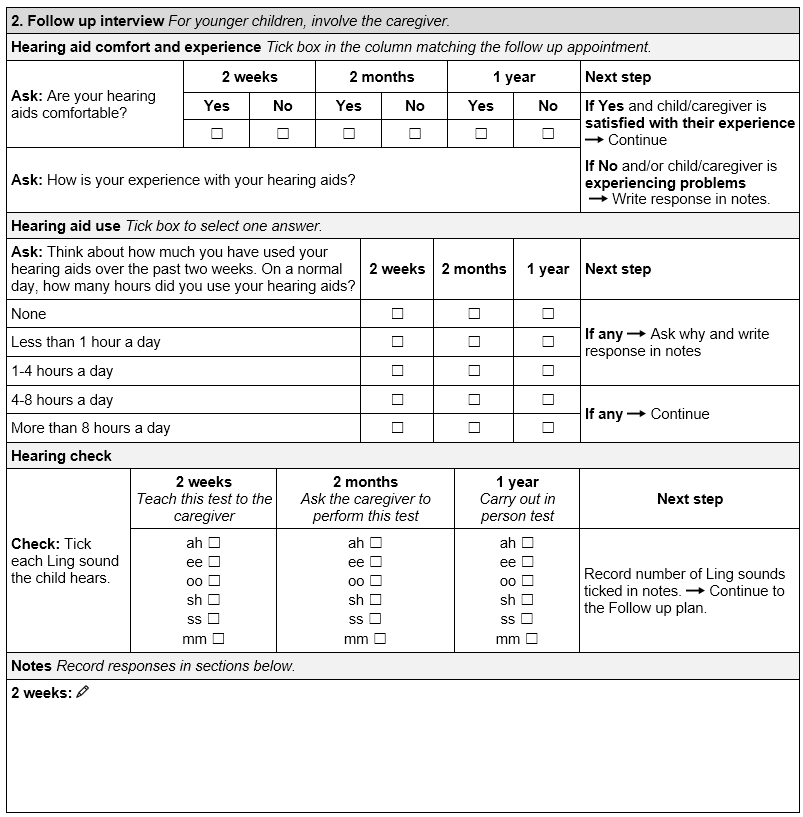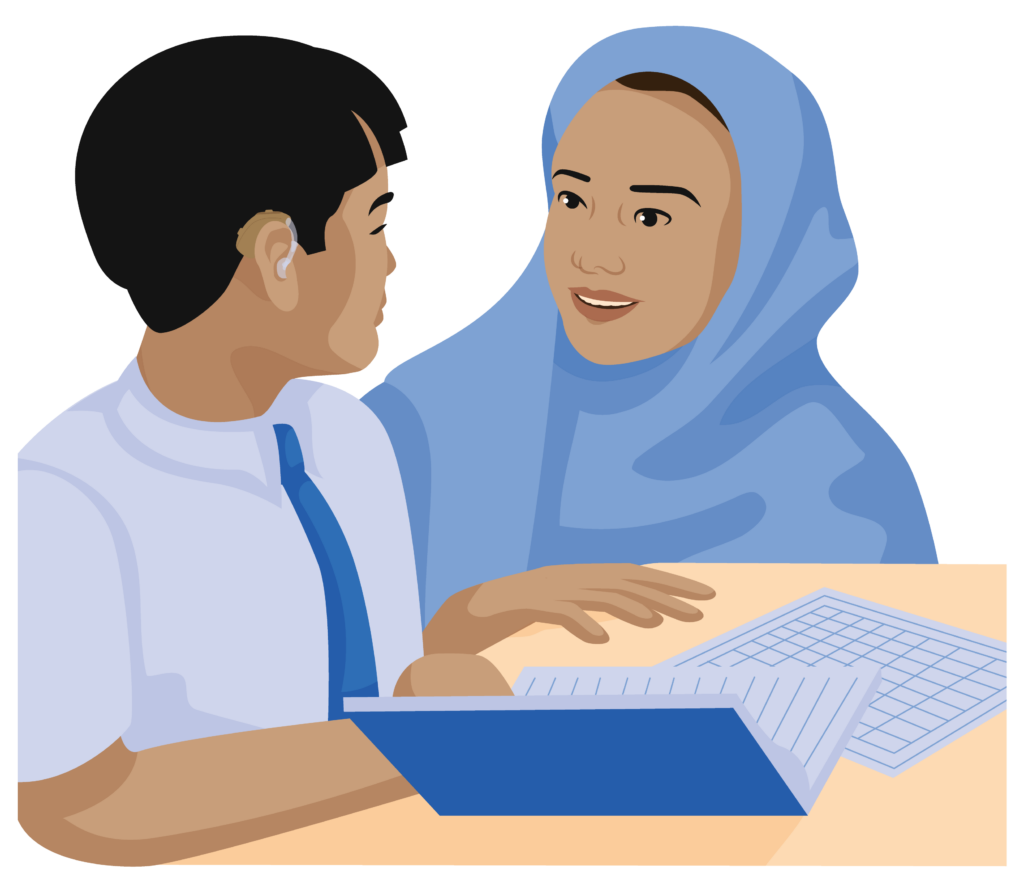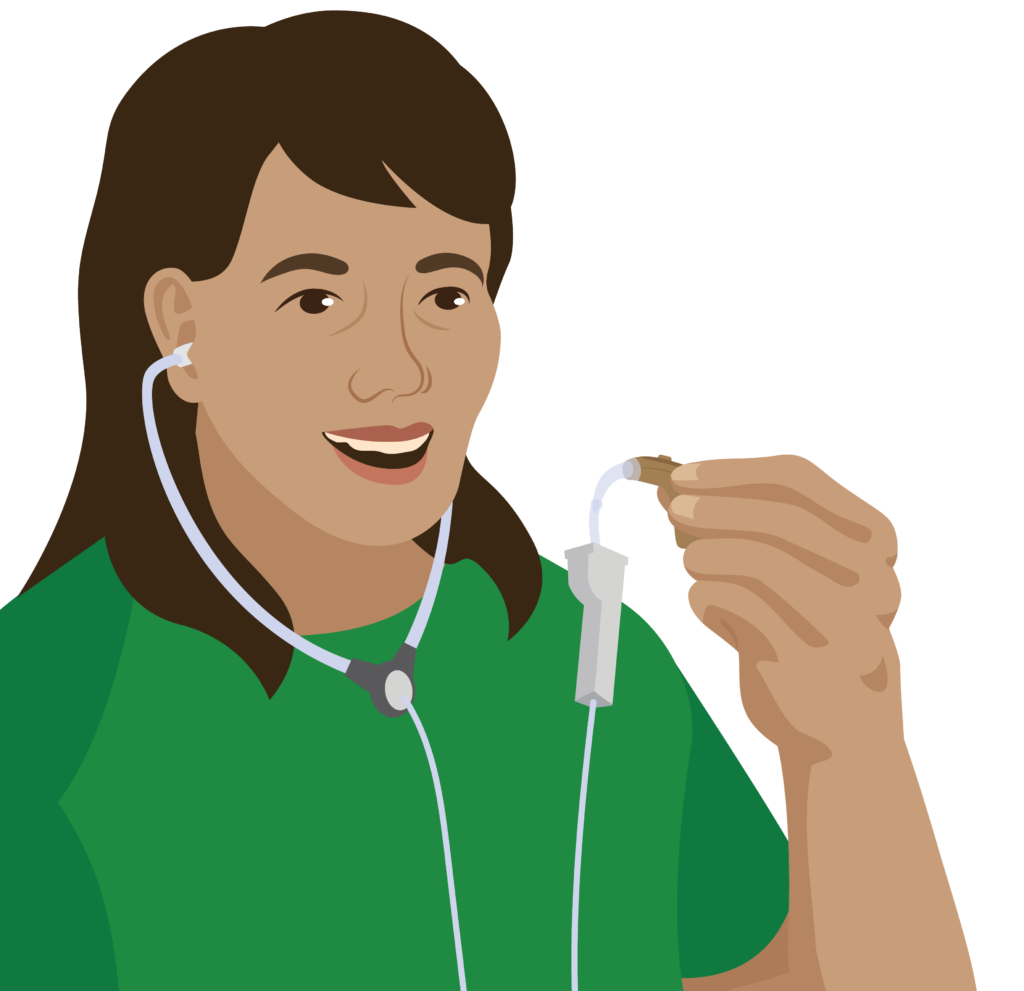Instruction
Dans cette rubrique, vous apprendrez à assurer le suivi d'un enfant équipé d'une aide auditive.
Si ce n'est pas déjà fait, téléchargez le formulaire TAP de suivi des enfants équipés d'une aide auditive et imprimez-en une copie.
Fréquence du suivi
Il est conseillé de faire un suivi à deux semaines et à deux mois pour aider l'enfant à s'adapter à son aide auditive programmable et à en tirer le meilleur parti. Les enfants doivent être réévalués tous les ans.
Lieu du suivi
Le suivi peut être assuré :
- à distance par téléphone ou par appel vidéo ; ou
- en personne.
Suivi en personne
En général, la décision de conduire le suivi à distance ou en personne dépend de ce qui est le mieux adapté à la situation de l'enfant. Toutefois, certains rendez-vous de suivi doivent se tenir en personne.
Pour un enfant, les rendez-vous suivants doivent se tenir en personne :
- le premier rendez-vous de suivi
- les rendez-vous de réévaluation annuels.
Pourquoi faire un suivi ?
Le suivi vous aidera à déterminer si :
- l'aide auditive répond aux besoins de l'enfant
- l'aide auditive doit être réparée ou remplacée
- l'aide auditive est toujours bien ajustée
- l'enfant a besoin d'être conseillé pour utiliser son aide auditive correctement et sans danger.
Suivi des enfants
Le suivi présenté ici s'applique aux enfants de 5 à 17 ans.
Les enfants de moins de cinq ans doivent être orientés vers un spécialiste de l'oreille et de l'audition en vue d'une évaluation et d'un suivi.
Renseignements sur l'enfant
Instruction
Commencez par recueillir des renseignements d'ordre général sur l'enfant et notez les coordonnées de la personne qui s'occupe de lui.
Entretien de suivi

Le même formulaire de suivi est utilisé pour les rendez-vous à :
- Deux semaines
- Deux mois
- Six mois
- Un an
Instruction
Cochez une case dans la colonne correspondant au rendez-vous de suivi.
Les besoins des enfants peuvent évoluer plus rapidement que ceux des adultes, car ils sont en pleine croissance. Il est recommandé de procéder à une réévaluation chaque année.
Il est important de vérifier que l'enfant tire pleinement parti de son aide auditive afin de favoriser ses apprentissages et ses activités sociales.
Bénéfices liés à l'utilisation d'une aide auditive
Trois critères permettent de déterminer si l'enfant tire pleinement parti de son aide auditive :
- Confort de l'aide auditive et satisfaction de l'utilisateur
- Utilisation de l'aide auditive
- Contrôle de l'audition.
1. Confort de l'aide auditive et satisfaction de son utilisateur
Adressez-vous à l'enfant et à la personne qui s'occupe de lui.
Posez des questions à l'enfant pour savoir s'il est satisfait du confort et de l'utilisation de son aide auditive.
Instruction
Posez les questions suivantes :
- Votre aide auditive est-elle agréable à porter ?
- Êtes-vous satisfait de son utilisation ?
- Si l'enfant confirme que son aide auditive ne le gêne pas et qu'il, ainsi que la personne qui s'occupe de lui, est satisfait de son utilisation, continuez.
- Si l'enfant ou la personne qui s'occupe de lui répond par la négative ou si l'enfant rencontre des problèmes, notez sa réponse dans vos notes.
2. Utilisation de l'aide auditive
Instruction
Question : Pense au temps que tu as porté ton aide auditive ces deux dernières semaines. Au cours d'une journée normale, combien d'heures l'as-tu portée ?
- Si l'enfant porte habituellement son aide auditive moins de quatre heures par jour, il n'en tire pas suffisamment parti. Demandez-lui pourquoi et notez sa réponse dans vos notes.
- Si l'enfant porte habituellement son aide auditive quatre heures ou plus au quotidien, continuez.
3. Contrôle de l'audition
Le premier rendez-vous de suivi se fait en personne.
Il est important d'enseigner le test des sons de Ling à la personne qui s'occupe de l'enfant afin qu'elle puisse l'utiliser à la maison pour s'assurer que l'aide auditive de l'enfant fonctionne normalement.
Montrez-lui les sons et exercez-vous ensemble avant de faire le test avec l'enfant.
Instruction
Conseillez à la personne qui s'occupe de l'enfant de faire un test d'écoute au quotidien une fois que l'enfant a mis son aide auditive.

Pour que l'enfant tire parti de son aide auditive, il doit entendre au moins cinq des six sons de Ling. Cochez chaque son que l'enfant perçoit.
Notez le nombre de sons de Ling cochés dans la section Notes et passez au plan de suivi.
Plan de suivi

Utilisez cette partie du formulaire pour vous aider, ainsi que l'enfant et la personne qui s'occupe de lui, à décider des mesures à prendre.
Utilisez les réponses de l'entretien pour élaborer le plan de suivi.
Encouragez toujours la personne qui s'occupe de l'enfant à revenir vous voir à tout moment si l'enfant éprouve des difficultés avec son audition ou son aide auditive.
Suivi à deux semaines et à deux mois
Commencez par passer en revue les réponses aux questions pour savoir si l'enfant ou la personne qui s'occupe de lui rencontre des problèmes.
Une personne tire pleinement parti de son aide auditive si les conditions suivantes sont réunies :
- le port et l'utilisation de son aide auditive lui donnent satisfaction
- elle utilise son aide auditive plus de quatre heures par jour
- elle entend au moins cinq des six sons de Ling.
Instruction
- Si l'enfant répond oui à toutes les questions, il tire pleinement parti de son aide auditive. Posez le prochain rendez-vous de suivi.
- Si l'enfant répond non à une des questions, il ne tire pas pleinement parti de l'aide auditive. Vérifiez les notes et tentez de trouver une solution. Si le problème persiste, effectuez un suivi en personne pour vérifier l'état des oreilles et du produit.
- Si vous ne trouvez pas de solution, parlez-en avec votre mentor et, au besoin, orientez l'enfant vers un spécialiste de l'oreille et de l'audition.
Vous souvenez-vous de Basir ?

Basir est un écolier à qui on a fourni une aide auditive programmable.
Basir se rend avec son père à un rendez-vous de suivi à deux semaines. Il porte son aide auditive deux heures par jour.
L'agente de santé le questionne afin de comprendre pourquoi. Basir explique qu'il n'a pas l'habitude de porter d'aide auditive et qu'il l'enlève quand il joue avec ses amis.
L'agente de santé lui explique qu'il sera plus facile de jouer avec ses amis s'il porte son aide auditive et elle l'encourage à la porter davantage au quotidien.
Ils planifient un appel de suivi dans deux semaines pour voir comment il s'y habitue.
Suivi à six mois - aide auditive uniquement
Les enfants peuvent user leur aide auditive prématurément. Il est conseillé de vérifier le produit régulièrement.
Demandez à la personne qui s'occupe de l'enfant d'apporter l'aide auditive dans le service en vue d'une vérification à six mois.
Rappelez-lui de mettre l'aide auditive dans son boîtier pendant le transport afin de la protéger.
Vérification du produit
Vérifiez le fonctionnement de chaque prothèse à l'aide d'un tube d'écoute. Vous devez :
- nettoyer et vérifier chaque prothèse
- remplacer les pièces usées ou endommagées. Au besoin, consultez le tableau de résolution des problèmes. Si cela ne suffit pas, parlez-en avec votre mentor. Si nécessaire, envoyez l'aide auditive au fabricant
- planifier une réévaluation dans un an.

Suivi à un an
Ce rendez-vous est une réévaluation. Il doit avoir lieu en personne.
Vous aurez besoin d'un formulaire de dépistage, du formulaire d'évaluation initiale de l'enfant et d'un formulaire de suivi.
Il est également important de vérifier que chaque prothèse est propre et en état de fonctionnement.
Instruction
Refaites les deux examens suivants :
- Examen des oreilles
- Test de l'audition
Ajustez les paramètres de aide auditive si les résultats du test de l'audition ont changé.
Instruction
Pour tout supplément d'information sur l'examen des oreilles, reportez-vous au module TAP sur les produits d'assistance auditive.
Plan de suivi à un an
Continuez de poser des questions afin de déterrminer dans quelle mesure l'enfant tire parti de son aide auditive, notamment :
- Confort de l'aide auditive et satisfaction de l'utilisateur
- Utilisation de l'aide auditive
- Contrôle de l'audition.
Instruction
- Si l'enfant répond oui à toutes les questions, il tire pleinement parti de son aide auditive. Réévaluez dans un an (refaire l'examen des oreilles et le test de l'audition).
- Si l'enfant répond non à l'une des questions, il ne tire pas pleinement parti de son aide auditive. Relisez vos notes et le tableau de résolution des problèmes.
- Si vous ne trouvez pas de solution, parlez-en avec votre mentor et, au besoin, orientez l'enfant vers un spécialiste de l'oreille et de l'audition.
Question
Que faut-il faire si les résultats du test de l'audition de l'enfant ont beaucoup changé (plus d'un degré de perte d'audition, par exemple) ?
Sélectionnez une réponse.
Il faut en parler avec votre mentor.
Si l'audition de l'enfant a sensiblement changé dans l'une ou les deux oreilles, parlez-en toujours avec votre mentor et, si nécessaire orientez l'enfant vers un spécialiste de l'oreille et de l'audition.
Vérification du produit
Vérifiez le fonctionnement de l'aide auditive à l'aide du tube d'écoute.
Nettoyez et vérifiez chaque prothèse. Remplacez les pièces usées ou endommagées.
Si l'enfant ou la personne qui s'occupe de lui décrit des problèmes liés au fonctionnement de l'aide auditive, consultez le tableau de résolution des problèmes.
Question
De quoi avez-vous besoin pour vérifier l'aide auditive ?
Sélectionnez les propositions pour afficher les réponses.
Bonne réponse.
Il est important de vérifier et de nettoyer toutes les parties de l'aide auditive.
Bonne réponse.
Les pièces détachées telles que le coude, l'embout, le tube d'embout et la pile doivent être remplacées régulièrement.
Mauvaise réponse.
Ce tableau sert à vérifier l'acuité auditive de l'enfant avec son aide auditive.
Vous souvenez-vous de Basir ?

Basir est un écolier de six ans. Il porte une aide auditive programmable.
Il revient en consultation avec ses parents pour une réévaluation à un an. Il a plus de facilité à apprendre à l'école. Basir et ses parents sont satisfaits de l'aide auditive.
L'agente de santé examine les oreilles de Basir. Leur état est normal.
L'agente de santé procède à un nouveau test de l'audition. Le résultat du test a légèrement changé. Les paramètres de l'aide auditive de Basir sont ajustés. Son aide auditive fonctionne bien.
L'agente de santé demande aux parents de Basir de revenir avec lui pour une réévaluation dans un an ou plus tôt s'il éprouve des difficultés avec son audition ou son aide auditive.
Entretien, réparations et résolution de problèmes
L'entretien, les réparations et la résolution des problèmes constituent un aspect important du suivi.
Encouragez la personne qui s'occupe de l'enfant à revenir vous voir avec son enfant à tout moment si celui-ci rencontre des difficultés d'audition ou avec son aide auditive.
Instruction
Référez-vous au module TAP sur les aides auditives préprogrammées pour tout supplément d'informations sur l'entretien, les réparations et la résolution des problèmes.